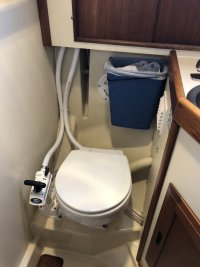peaman
Sustaining Member
I am in process of replacing all hoses connected to the toilet and holding tank in my 32-3. Some sources (Peggie Hall) say that there should be a vented loop in the seawater flush line between the head pump and the toilet, but there is none presently. I believe the existing plumbing arrangement is original, as there are no signs of modifications. Presently, there is a short hose from the seawater intake seacock to the pump inlet, and another hose from the seawater outlet directly to the rear of the toilet. The pump is a Raritan PHII which recently replaced an older version of the same model.
Should a vented loop be in place between the pump outlet and the toilet connection? And if so, how would that be installed: specifically, how high would the loop need to be to be 8-12" above the heeled waterline, and where would the loop and hose best be installed while maintaining a clean appearance?
Should a vented loop be in place between the pump outlet and the toilet connection? And if so, how would that be installed: specifically, how high would the loop need to be to be 8-12" above the heeled waterline, and where would the loop and hose best be installed while maintaining a clean appearance?

